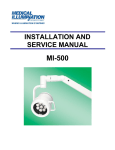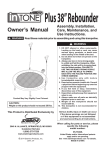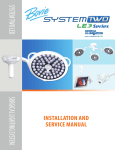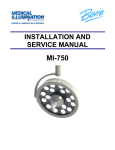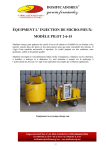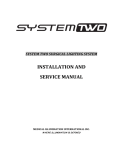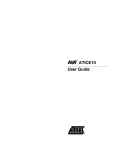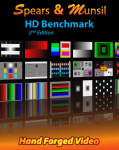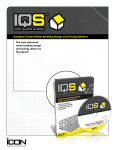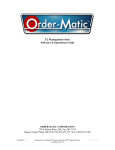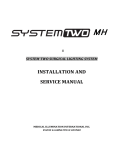Download Title Page - Bovie Medical Corporation
Transcript
INSTALLATION AND SERVICE MANUAL MI-500 Section 1 Section 1: General Information Agency Approvals Medical Electrical Equipment With respect to electric shock, fire and mechanical hazards only In accordance with UL60601-1:2006 / CAN/CSA C22.2 No.601.1-M90 with updates 1 & 2. Classifications: 1. Protection against electrical shock (5.1, 5.2). Class I permanently connected. 2. Protection against harmful ingress of water (5.3). None. 3. Degree of safety in the presence of flammable anesthetics or oxygen (5.5). Not suitable for use in the presence of flammable anesthetics or oxygen. 4. Mode of operation (5.6). Continuous. 5. Surgical luminaries (IEC60601-2-41) Minor. Electromagnetic compatibility for immunity and emissions in accordance with EN-60601-1-2(2001) Class A and CISPR 22 (1997) Class A Medical Electrical Equipment Particular requirements for the safety of surgical Luminaries and luminaires for diagnosis In accordance with IEC-60601-2-41 Intended use The MI-1000 and MI-500 are AC powered devices that provide a field of illumination for general examination and surgery. MI-500 Service Manual (1003465 Rev A) Page 1 Section 1 Disposal of Waste This product must not be disposed of with your other waste. Instead, it is your responsibility to dispose of your waste equipment by handing it over to a designated collection point for the recycling of waste electrical and electronic equipment, or by returning it to Medical Illumination International, Inc for reprocessing. The separate collection and recycling of your waste equipment at the time of disposal will help to conserve natural resources and ensure that it is recycled in a manner that protects human health and the environment. For more information about where you can drop off your waste equipment for recycling, please contact your local city office, your waste disposal service, or your product distributor or retailer. MI-500 Service Manual (1003465 Rev A) Page 2 Section 1 Revisions Rev. A ECO# Pages Affected Initial Release Date 04/12/12 Approvals Title Signature Date President Vice President of Marketing Manufacturing Manager Engineering Manager Quality Assurance Manager MI-500 Service Manual (1003465 Rev A) Page 3 Section 1 Table of Contents SECTION 1: GENERAL INFORMATION ............................................................................ 1 TABLE OF CONTENTS .......................................................................................................... 4 LIST OF SYMBOLS ............................................................................................................... 8 SECTION 2: PRODUCT SPECIFICATIONS ....................................................................... 9 LIMITED WARRANTY .......................................................................................................... 10 SECTION 3: INSTALLATION/ASSEMBLY ....................................................................... 12 CEILING MOUNT PRE-INSTALLATION GUIDELINES ................................................................ 12 CEILING STRUCTURE CONSTRUCTION AND MOUNTING ......................................................... 14 CEILING CALCULATION: SINGLE MOUNT DIMENSIONS .......................................................... 15 CEILING CALCULATION: DUAL MOUNT DIMENSIONS ............................................................ 16 SINGLE CEILING MOUNT INSTALLATION .............................................................................. 17 DUAL CEILING MOUNT INSTALLATION ................................................................................. 20 CEILING ROD CALCULATION .............................................................................................. 24 EXTENDED CEILING MOUNT INSTALLATION ......................................................................... 24 SECTION 4: SAFETY INSTRUCTIONS ............................................................................ 36 SECTION 5: MAINTENANCE ............................................................................................ 37 ARM ADJUSTMENT ............................................................................................................ 38 HEAD/YOKE ADJUSTMENT ................................................................................................. 39 CLEANING INSTRUCTIONS .................................................................................................. 40 MAINTENANCE SCHEDULE ................................................................................................. 41 SECTION 6: GENERAL TROUBLESHOOTING ............................................................... 42 MI-500 Service Manual (1003465 Rev A) Page 4 Section 1 List of Figures FIGURE 3: SINGLE CEILING MOUNT CALCULATION ........................................................................ 15 FIGURE 4: DUAL CEILING MOUNT CALCULATION ........................................................................... 16 FIGURE 5: SINGLE CEILING MOUNTING COMPONENTS ................................................................... 17 FIGURE 6: DUAL CEILING MOUNTING COMPONENTS ...................................................................... 20 FIGURE 7: W IRE HARNESS POSITIONING ...................................................................................... 22 FIGURE 8: W IRE CHANNEL .......................................................................................................... 22 FIGURE 9: EXTENDED CEILING MOUNT INSTALLATION ................................................................... 25 FIGURE 10: W ALL MOUNT INSTALLATION...................................................................................... 26 FIGURE 11: W ALL BRACKET MOUNTING DIAGRAM ........................................................................ 27 FIGURE 12:STUD ANCHOR INSTALLATIONS ................................................................................... 29 FIGURE 13: FLOOR STAND BASE INSTALLATION ............................................................................ 30 FIGURE 14: ARM ASSEMBLY TO UPRIGHT POLE INSTALLATION ....................................................... 32 FIGURE 15: LIGHT HEAD-ARM INSTALLATION ................................................................................ 34 FIGURE 16: ARM ADJUSTMENT .................................................................................................... 38 MI-500 Service Manual (1003465 Rev A) Page 5 Section 1 Definition of Terms I.E.C. International Electrotechnical Commission TUV TUV SUD America, Safety Assurance Agency Medical Electrical Equipment Electrical equipment intended to diagnose, treat the patient under medical supervision. Electrical equipment that transfers energy to the patient. Central Illuminance Illuminance of light head measured at 1 meter from the light emitting area with no obstructions. Expressed in Foot-candles or Lux. Light Field Center Point of maximum illuminance in lighted area. This is the reference point for light field size and light distribution measurements. Light Field Diameter Diameter of the circle where illuminance reaches 10% of light field center illuminance. Depth of Illumination The overall distance from 1 meter where the central illuminance is reduced to 20%. Shadow Dilution Ability of the equipment to minimize the impact of shadows in the working area. Shadows can be due to partial obstruction by the operator or other medical personnel. Correlated Color Temperature The color temperature of the light fixture when compared to a blackbody radiator expressed in Kelvin. Total Irradiance The total amount of energy imparted to the patient by the lighting system expressed in Watts/meter squared. Color Rendering Index (CRI) A method of how well a light source will render other colors when illuminating them based upon eight CIE chromaticity coordinates measured with a spectroradiometer. Sterilizable Handle An easily removed device that maintains a sterile area in order to handle it under aseptic conditions when attached to the equipment after being properly sterilized. Light Head/Yoke The Light Head/Yoke includes the light source, controls/indicators, handles, Positioning Pivot points and the Articulating Arm attachment. Articulating Arm The Articulating Arm provides vertical positioning of the Light Head/Yoke. Attaches to the Extension Arm. MI-500 Service Manual (1003465 Rev A) Page 6 Section 1 Definition of Terms (cont’d) Extension Arm The Extension Arm is the horizontal section of the positioning arm with pivots on both ends that is used to increase the area covered by the light head and articulating arm. Light Mounting Support apparatus used to connect Light Head/Arm Assembly to a fixed surface, consisting of either a Single or Dual Ceiling mount, wall mount, or track mount. Light head/Arm Assembly may also be used with a mobile floor mount Neutral Conductor In an AC circuit, the return line for current. Protective Earth Ground The conductor used to connect the non-current-carrying metal parts of equipment, raceways, and other enclosures to the system grounded conductor, the grounding electrode conductor, or both, of the circuit at the service equipment or at the source of a separately derived system. Ft-Lbs. Foot-pounds. A unit of measurement of torque derived from by a cantilever load. PSU Power Supply Unit. MI-500 Service Manual (1003465 Rev A) Page 7 Section 1 List of Symbols TUV Listing Marking Consult accompanying documents C.E. Marking Protective Earth Ground Caution / Warning Electric Shock Hazard Temperature Humidity Waste Disposal MI-500 Service Manual (1003465 Rev A) Page 8 Section 2 Section 2: Product Specifications Mechanical Parameter Weight Head Arm Arm (Floor) Wall Bracket Assy. Floor Stand Assy. Single Ceiling Mount Dual Ceiling Mount Dimensions Head Arm Arm (Floor) Floor Stand Rotations Articulating Arm Vertical Movement Articulating Arm Horizontal Movement Articulating Arm/Yoke Interface Yoke/Lamp Head Interface Value Approximately 3.5 lbs. (1.59 kg). Approximately 12.5 lbs. (5.7 kg). Approximately 11.5 lbs. (5.2 kg). Approximately 3.0 lbs. (1.4 kg). Approximately 43.0 lbs. (19.5 kg). Approximately 14.5 lbs. (6.6 kg). Approximately 16.0 lbs. (7.3 kg). 6.25” ( mm) Diameter X 6.50” High ( mm) 57.0” (1448 mm) Long 38.5” (978 mm) Long 74.5” (1892 mm) High +/- 40 Degrees travel Approximately 345 Degrees Approximately 540 Degrees Approximately 190 Degrees Electrical Parameter Input Voltage Power Consumption LED life Value 100 – 240 VAC 50/60 Hz Approx 50W max 50,000 hours (average) Optical Parameter 8 Inner optics Performance Color temperature Focal length Central illuminance (full intensity) Value Clear acrylic, single-source 4,300°K ±300°K 24” 4,650 foot-candles (50,000 Lux) Environmental Parameter Operating Temperature Storage Temperature Range Humidity MI-500 Service Manual (1003465 Rev A) Value 41-104 °F (5-40 °C) 41-113 °F (5-45 °C) 10 - 90% Relative Humidity Page 9 Section 2 Limited Warranty Medical Illumination International, Inc. - Lighting Equipment This document comprises the general terms of your product’s Limited Warranty. By accepting the shipment of the product, the owner/purchaser agrees to adhere to the warranty terms and conditions expressed herein. Medical Illumination International, Inc. (“Medical Illumination”) Lighting Equipment is warranted against defective material and/or workmanship, excluding normal replacement parts (e.g. bulbs, sterilizable handles or glass items), for a period of three (3) years from the date of shipment. This Limited Warranty applies exclusively to the repair or replacement of parts recognized as defective by Medical Illumination, that are in normal use and have not been modified or repaired by unauthorized personnel. This Limited Warranty extends only to the first retail purchaser of a product, and is not transferable or assignable. This warranty supersedes all other guarantees or warranties, expressed or implied. WARRANTY SERVICE & REPAIRS Medical Illumination does not provide (or give any compensation for) outside repair services or field labor. Therefore, in the event of a failure covered under this warranty, please take the following immediate action: 1. Contact Medical Illumination via phone at (818) 838-3025, through our website at http://www.medillum.com or by facsimile at (818) 838-3725. A. Be prepared to give the model number, serial number, and full description of the failure. B. Our Customer Service Department will attempt to solve the problem over the phone. If it becomes necessary to send the product to the factory for repair, you will be provided with a Return Authorization number. Products sent to the factory without a Return Authorization number will not be accepted. 2. It is the retail purchaser’s obligation to arrange for shipment return of a product to the factory for warranty service, which shall be at the retail purchaser’s expense. Carefully package the light component (light head, arm assembly, mount assembly, etc.) and return it, freight prepaid and insured, with the Return Authorization number clearly marked on the outside of the box, to: Medical Illumination 547 Library Street San Fernando, CA 91340 RA#______ MI-500 Service Manual (1003465 Rev A) Page 10 Section 2 Limited Warranty (cont’d) Damage resulting from inadequate packing is not covered by this warranty, and shipping insurance does not cover damage due to inadequate packing. We recommend that the package be insured against loss or in-transit damage. Medical Illumination cannot be held responsible for in-transit loss or damage. In the event that freight-related damage should occur, Medical Illumination will notify you immediately so that you can file a damage claim with the proper freight carrier. Within the aforementioned time period of three (3) years from date of shipment, Medical Illumination will evaluate the returned product, repair as appropriate, and ship the product back to you with freight costs prepaid by the Company. In the event that non-warranty damage or failure is discovered, you will be contacted before any repairs are performed. EXCLUSIONS: This Limited Warranty does not cover the following: • Any field labor or outside services (electricians, contractors, installation services, routine maintenance or other repair services). • Damage to the product resulting from tampering, accident, abuse, negligence, alteration, or other causes unrelated to problems with material and/or workmanship; • Damage due to improper installation, use, cleaning or maintenance, as outlined in the Installation and Service Manual for the product; • Labor costs associated with removing, re-packaging for shipment or reinstalling product; PRODUCT RETURNS: Please contact the authorized dealer from whom the product was purchased to inquire about a product return. Additional terms and conditions set by the dealer may apply for any returned items. SHIPMENT DAMAGE: If the initial shipment of your purchased product arrived in damaged condition, please file a claim with the carrier and contact Medical Illumination immediately. MI-500 Service Manual (1003465 Rev A) Page 11 Section 3 Section 3: Installation/Assembly Ceiling Mount Pre-Installation Guidelines SPECIAL NOTE: Installation and repair of this equipment should be performed by qualified personnel only. The product’s Limited Warranty does not cover damage occurring as a result of improper installation. It is recommended that this installation manual be completely reviewed prior to installation. Prior to installation, check to ensure that the following minimum conditions are provided: Ceiling Mount Single Ceiling Dual Ceiling Weight (Lbs): 70 115 Moment (Ft Lbs): 215 350 ← recommended Medical Illumination strongly recommends that the ceiling structure be designed to support the weights and moments for the heaviest load (dual ceiling). A structural mount that does not meet these minimum conditions can cause serious injury and/or property damage. • The ceiling structure must be strong enough to support the weight and rigid enough to constrain rotation to less than 0.1° at the ceiling casting. • The equipment may be mounted directly over a 4-0 junction box. Input power supply lines should be wired in accordance with all applicable building codes. The equipment is not compatible with any sort of electrical dimming device or wall switch. Use line voltage only. To maintain proper grounding reliability, the ground wire connections with the wall bracket must be kept properly fastened at all times. The supply circuit line must be as follows: 100-240VAC, 50/60 Hz, single phase, three-wire capable of supplying 50 Watts @ 2A. • The power supply circuit line must be routed and wired to the wire harness in compliance with all applicable building codes. Failure to provide a circuit meeting these minimum standards or complying with local building codes can cause a shock hazard. • Check the length of the ceiling rod supplied to make sure that it is the proper length to install and operate the light without interference or over reach. MI-500 Service Manual (1003465 Rev A) Page 12 Section 3 Improper fastening of the ceiling casting can cause serious injury and/or property damage. • Mount the Ceiling casting to the ceiling structure using four 3/8” diameter A325 bolts with nuts and washers as shown in Figure 2: Recommended Ceiling Structure Construction. Figure 1: Ceiling Casting Mount Diagram MI-500 Service Manual (1003465 Rev A) Page 13 Section 3 Ceiling Structure Construction and Mounting The ceiling mount system will experience various levels of dynamic off-center moment during regular use. Therefore, it is crucial that the ceiling structure to be strong enough to uphold the weight of the system and support the positioning arms and light head without deflection. The owner and/or owner’s contractor has the final responsibility for the strength and rigidity of the ceiling structure. An inadequate ceiling may result in unintended drift and/or equipment damage. Because the ceiling structure is the owner’s responsibility, the design and construction recommendation shown below (Figure 2: Recommended Ceiling Structure Construction) covers only one of the many possible alternatives that can be used. Medical Illumination highly recommends that the owner consult a structural engineer prior to designing and installing the ceiling structure. Recommended Ceiling Structure Construction Details The illustrations below are suggested mounting schemes per 2001 California Building Code – Section 1632A: Anchorage and Seismic. For any other mounting scheme, please consult a structural engineer and/or professional contractor for the best solution for your situation. Installation and repair of this equipment should be performed by qualified persons only. Medical Illumination does not warranty any damage occurring as a result of improper installation. Figure 2: Recommended Ceiling Structure Construction MI-500 Service Manual (1003465 Rev A) Page 14 Section 3 Ceiling Calculation: Single Mount Dimensions Use the following table to select the correct length ceiling rod for your application. Ceiling Rod Calculation, Single Ceiling Mount Ceiling Mounting Height (Y-Value) Ceiling Rod Length “X” Value 7’10” - 8’6” 8’7” - 9’4” 9’5” - 10’1” 10'2" - 10'10" 10'11" - 11'8" 11'9" - 12'0" 12'1" - 12'10" 12'11" - 14'0" 16” 25” 35” 44” 53” 63” 67” 77” 22” 31” 41” 50” 59” 69” 73” 83” Head room to bottom of extension arm (y-value – x-value) 6'2" - 6'11" 6'2" - 7'0" 6'2" - 6'11" 6'2" - 6'11" 6'2" - 7'0" 6'2" - 6'6" 6'2" - 7'0" 6'2" - 7'3" Figure 3: Single Ceiling Mount Calculation MI-500 Service Manual (1003465 Rev A) Page 15 Section 3 Ceiling Calculation: Dual Mount Dimensions Use the following table to select the correct length ceiling rod for your application. Ceiling Rod Calculation, Dual Ceiling Mount Ceiling Mounting Height (Y Value) Ceiling Rod Length “X” Value 7’10” - 8’6” 8’7” - 9’4” 9’5” - 10’1” 10'2" - 10'10" 10'11" - 11'8" 11'9" - 12'0" 12'1" - 12'10" 12'11" - 14'0" 16” 25” 35” 44” 53” 63” 67” 77” 23” 32” 42” 51” 60” 70” 74” 84” Head room to bottom of extension arm (y-value – x-value) 6'1" - 6'10" 6'1" - 6'11" 6'1" - 6'10" 6'1" - 6'10" 6'1" - 6'11" 6'1" - 6'5" 6'1" - 6'11" 6'1" - 7'2" Figure 4: Dual Ceiling Mount Calculation MI-500 Service Manual (1003465 Rev A) Page 16 Section 3 Single Ceiling Mount Installation Figure 5: Single Ceiling Mounting Components GENERAL INFORMATION The shipping cartons contain a light head assembly, arm assembly, a wall bracket assembly with a hospital grade plug attached, hardware kit, and an Installation and Service Manual. (Mounting hardware for attaching the wall bracket to the wall is not supplied). Prior to installation ensure that all of the components shown in Figure 5: Single Ceiling Mounting Components are present. MI-500 Service Manual (1003465 Rev A) Page 17 Section 3 When removing parts from the shipping carton, be careful not to damage the components. Important: thoroughly check each box for parts that may be located in areas that can be overlooked. Install Ceiling Casting referenced in Figure 1 on page 13. Insert the ceiling rod up through the ceiling casting until the hole in the ceiling rod becomes visible. Insert the dowel pin into the hole in the ceiling rod and lower the rod in the ceiling casting, making sure the pin is seated securely in the indentation on the ceiling casting. Securely tighten the two set-screws located in the casting. Failure to install the dowel pin can cause the arm/head assembly to fall from the ceiling causing serious injury and/or property damage. The ceiling casting must be properly grounded during installation. This can be done by mounting the casting to a suitable material that will function as a ground conductor, or a wire lead that must be attached to the ground screw on the casting then routed to proper ground (Figure 1: Ceiling Casting Mount Diagram). If ceiling rod is not plumb, unwanted arm drifting may occur. • Feed the wire harness through the ceiling rod extension and route to a junction box. Leave sufficient wire to extend slightly beyond the bottom of the ceiling rod. Important: To achieve proper grounding reliability, the green ground wire from the wire harness MUST be properly fastened to the grounding screw located on the ceiling casting • Make all electrical connections in compliance with all applicable electrical codes. The equipment is not compatible with any sort of electrical dimming device or wall switch. Use line voltage only. To maintain proper grounding reliability, the ground wire connections with the wall bracket must be kept properly fastened at all times The supply circuit line must be as follows: 100-240VAC, 50/60 Hz, single phase, three-wire capable of supplying 50 Watts @ 2A. • Failure to comply with local electrical codes can cause a shock hazard. Slide the casting cover up the rod over the casting. Similarly, slide the collar to the casting cover, then tighten the set screw to hold the cover in place. Feed the wire harness through the ceiling rod with the rod in the direction shown. MI-500 Service Manual (1003465 Rev A) Page 18 Section 3 Do not install the extension arm with the light head attached. Installation with the light head attached can cause damage to the light. Refer to the procedure for installing the head to the arm after the bracket and arm are installed. • Slide the Bolt Cover up onto the ceiling rod as shown in Figure 6, then raise the Extension Arm Assembly to the Ceiling Rod and plug the Molex connectors together. Push the wire into the ceiling rod while inserting the Extension Arm Assembly into the rod. Secure the housing to the ceiling rod using the four supplied bolts as shown. Two 1/4-20 x 1/4” screws must be installed on one side of the ceiling rod. Two 1/4-20 x 3/8” screws and lock washers must be used to mount the stop bracket on the other side of the rod. Be sure the bend on the stop faces down, towards the arm. Failure to install the stop clip subassembly can cause damage to the light fixture. Failure to install or tighten the 1/4-20 socket head cap screw can cause the arm/head assembly to fall causing serious injury and/or property damage. • Complete the installation by lowering the bolt cover onto the transformer housing. MI-500 Service Manual (1003465 Rev A) Page 19 Section 3 Dual Ceiling Mount Installation Figure 6: Dual Ceiling Mounting Components GENERAL INFORMATION The shipping cartons contain a light head assembly, arm assembly, a wall bracket assembly with a hospital grade plug attached, hardware kit, and an Installation and Service Manual. (Mounting hardware for attaching the wall bracket to the wall is not supplied). Prior to installation ensure that all of the components shown in Figure 6: Dual Ceiling Mounting Components are present. MI-500 Service Manual (1003465 Rev A) Page 20 Section 3 When removing parts from the shipping carton, be careful not to damage the components. Important: thoroughly check each box for parts that may be located in areas that can be overlooked. Install Ceiling Casting referenced in Figure 1 on page 13. • Insert the ceiling rod up through the ceiling casting until the hole in the ceiling rod becomes visible. Insert the dowel pin into the hole in the ceiling rod and lower the rod in the ceiling casting, making sure the pin is seated securely in the indentation on the ceiling casting. Securely tighten the two set-screws located in the casting. Failure to install the dowel pin can cause the arm/head assembly to fall from the ceiling causing serious injury and/or property damage. The ceiling casting must be properly grounded during installation. This can be done by mounting the casting to a suitable material that will function as a ground conductor, or a wire lead that must be attached to the ground screw on the casting then routed to proper ground (Figure 1: Ceiling Casting Mount Diagram). If ceiling rod is not plumb, unwanted arm drifting may occur. • Feed the wire harness through the ceiling rod extension and route to a junction box. Leave sufficient wire to extend slightly beyond the bottom of the ceiling rod. Important: To achieve proper grounding reliability, the green ground wire from the wire harness MUST be properly fastened to the grounding screw located on the ceiling casting. • Make all electrical connections in compliance with all applicable electrical codes. The equipment is not compatible with any sort of electrical dimming device or wall switch. Use line voltage only. To maintain proper grounding reliability, the ground wire connections with the wall bracket must be kept properly fastened at all times The supply circuit line must be as follows: 100-240VAC, 50/60 Hz, single phase, three-wire capable of supplying 120 Watts @ 2A. Failure to comply with local electrical codes can cause a shock hazard. • Slide the casting cover up the rod extension and over the casting. Similarly, slide the collar to the casting cover, then tighten the set screw to hold the cover in place. MI-500 Service Manual (1003465 Rev A) Page 21 Section 3 • Feed the wire harness through the 35” ceiling rod with the rod in the direction shown. Slide ceiling rod up through ceiling rod extension until the holes in the ceiling rod align with the upper holes in the ceiling rod extension. Insert a 1/4-20 x 2” bolt carefully, making certain not to damage the wire harness, and then fasten the cap nut. Secure rods in place with the two set screws provided. • See the Dual Ceiling Mount Installation section to complete the assembly. Figure 7: Wire Harness Positioning Plug the connector at the end of each arm assembly to the mating Molex connector from the wire harness (Figure 7: Wire Harness Positioning). Place each set of wires within the channel area. Figure 8: Wire Channel MI-500 Service Manual (1003465 Rev A) Page 22 Section 3 Position the two extension arms (Figure 8: Dual Ceiling Mount Installation) to allow for easier mounting of the remaining Dual mount section. Firmly press the fastened dual ceiling mount section against the ceiling rod. While firmly holding the Dual ceiling mount section with arms attached in place, remove only the cap nuts from the 2” long bolts. It is strongly recommended that a second person hold the arms in place while the nuts are removed. Place the remaining dual ceiling mount section onto the bolts. Be sure the wires are enclosed within the wire channel to avoid pinching them. Replace the cap nuts and fully tighten. Install the remaining four 3/8” long mounting screws and then fully tighten all eight screws. Failure to tighten the cap nuts for the 2” long bolts may allow the arm/head assembly to fall causing serious injury and/or property damage. Failure to install or tighten all eight of the 3/8” mounting screws may allow the arm/head assembly to fall causing serious injury and/or property damage. • Check to make sure that the wire connections are seated far enough into the dual ceiling casting enclosure. Fasten the cover plates to the casting enclosure using the four 3/8” long pan-head screws (P/N 0001319) and plastic grommets (P/N 0001306) supplied in the hardware kit (P/N 1002060-KIT). MI-500 Service Manual (1003465 Rev A) Page 23 Section 3 Ceiling Rod Calculation Use the following table to select the correct length ceiling rod for your application. Base Rod Ext. Rod Ext. Mount Kit 25” 34” 1000976-53 35” 34” 1000976-63 25” 48” 1000976-67 35” 48” 1000976-77 Extended Ceiling Mount Installation For 10’2” – 14’ (3.23m-4.27m) Ceilings MI-500 Service Manual (1003465 Rev A) Page 24 Section 3 Figure 9: Extended Ceiling Mount Installation Insert the ceiling rod up through the ceiling casting until the hole in the ceiling rod becomes visible. Insert the dowel pin into the hole in the ceiling rod and lower the rod in the ceiling casting, making sure the pin is seated securely in the indentation on the ceiling casting. Securely tighten the two set-screws located in the casting. Failure to install the dowel pin can cause the arm/head assembly to fall from the ceiling causing serious injury and/or property damage. The ceiling casting must be properly grounded during installation. This can be done by mounting the casting to a suitable material that will function as a ground conductor, or a wire lead that must be attached to the ground screw on the casting then routed to proper ground (Figure: 1 Ceiling Casting Mount Diagram). Note: Ceiling rod must be plumb. Adjust the nuts/washers in Figure 2 accordingly. If ceiling rod is not plumb, unwanted arm drifting may occur. Feed the wire harness through the ceiling rod extension and route to a junction box. Leave sufficient wire to extend slightly beyond the bottom of the ceiling rod. Important: To achieve proper grounding reliability, the green ground wire from the wire harness MUST be properly fastened to the grounding screw located on the ceiling casting (Figure 1: Ceiling Casting Mount Diagram. Make all electrical connections in compliance with all applicable electrical codes. • Failure to comply with local electrical codes can cause a shock hazard. • Slide the casting cover up the rod extension and over the casting. Similarly, slide the collar to the casting cover, then tighten the set screw to hold the cover in place. • Feed the wire harness through the 35” ceiling rod with the rod in the direction shown. Slide ceiling rod up through ceiling rod extension until the holes in the ceiling rod align with the upper holes in the ceiling rod extension. Insert a 1/4”-20 x 2” bolt carefully, making certain not to damage the wire harness, and then fasten the cap nut. Secure rods in place with the two set screws provided. • See the Single or Dual Ceiling Mount Installation section to complete the assembly. MI-500 Service Manual (1003465 Rev A) Page 25 Section 3 Wall Mounted Light Installation GENERAL INFORMATION The shipping cartons contain a light head assembly, arm assembly, a wall bracket assembly with a hospital grade plug attached, hardware kit, and an Installation and Service Manual. (Mounting hardware for attaching the wall bracket to the wall is not supplied). Prior to installation ensure that all of the components shown in Figure 10: Wall Mount Installation are present. When removing parts from the shipping carton, be careful not to damage the components. Important: thoroughly check each box for parts that may be located in areas that can be overlooked. Figure 10: Wall Mount Installation MI-500 Service Manual (1003465 Rev A) Page 26 Section 3 Figure 11: Wall Bracket Mounting Diagram MI-500 Service Manual (1003465 Rev A) Page 27 Section 3 Wall Mounted Light Installation Improper fastening of the wall bracket can cause serious injury and/or property damage. Make certain the installation is capable of supporting a load of at least 65 pounds and an off center moment of 195 ft-lbs. The supply circuit line must be as follows: 100-240VAC, 50/60 Hz, single phase, three-wire capable of supplying 50 Watts @ 2A. The equipment is not compatible with any sort of electrical dimming device or wall switch. Use line voltage or an approved wall power socket only. To maintain proper grounding reliability, use only approved 3-prong power connection with the wall socket. Do not install the extension arm with the light head attached. Installation with the light head attached can cause damage to the light. Refer to the procedure for installing the head to the arm after the bracket and arm are installed. Recommended Wall Structure Construction Details The illustrations below are suggested mounting schemes per 2001 California Building Code – Section 1632A: Anchorage and Seismic. For any other mounting scheme, please consult a structural engineer and/or professional contractor for the best solution for your situation. Installation and repair of this equipment should be performed by qualified persons only. Medical Illumination does not warranty any damage occurring as a result of improper installation. Wall mounting with load anchor or stud Wall mounting with Backing Plate (not anchor provided) Concrete Wall (3000 PSI min., 6” thick min.): • Use two 3/8” diameter HILTI KB3 Expansion Anchors or approved equivalent bolts (min. embed. 3”). Also see HILTI technical document ESR-2302 for additional concrete anchoring information. MI-500 Service Manual (1003465 Rev A) Lattice stone, cinder block, etc. (min. 5/8”wall board thickness): • Use two 3/8” diameter A307 Bolts with nuts/washers to Backing Plate Page 28 Section 3 • • • • Drill hole according to the diameter of the stud anchor Thoroughly clean hole – removing all debris Insert anchor into hole (min. embed 3”) Torque the nut down against the washer to 20 ft-lb (see HILTI tech. doc. ESR-2302 Table 1 for reference) Figure 12:Stud Anchor Installations • Remove the four screws holding the cord retainer plate in place. Carefully pull the plate away from the wall bracket to expose the Molex connector. DO NOT use excessive force during this procedure or in any way loosen or disconnect the green wires within the bracket. • Bring the extension arm over the wall bracket and feed the Molex connector from the transformer housing into the bracket while inserting the housing into the bracket. Secure the housing to the bracket with the flat head cap screw provided. • Bring the cord retainer plate up to the bottom of the wall bracket and plug the Molex connector at the end of the power cord to the connector from the transformer. Route the connectors and wire to the rear of the bracket (not shown). Refasten the retainer plate to the bracket with the four screws provided. MI-500 Service Manual (1003465 Rev A) Page 29 Section 3 Floor Stand Light Installation GENERAL INFORMATION The shipping carton contains a light head assembly, arm assembly, floor base casting, two leg assemblies, a hardware kit, and an Installation and Service Manual. A second carton contains the upright pole assembly. Prior to installation insure that all components are present. When removing parts from the shipping carton, be careful not to damage the components. Important: thoroughly check each box for parts that may be located in areas that can be overlooked. Figure 13: Floor Stand Base Installation MI-500 Service Manual (1003465 Rev A) Page 30 Section 3 • Bolt the assembled legs onto the cast iron base using four 1/4”-20 x 1-3/4” bolts and 1/4” lock washers. Position the floor base casting so that the set-screw in the base is at the rear of the assembly (Figure 13: Floor Stand Base Installation). • Insert the upright pole fully into the floor base casting so that the anti-rotation slot sits over the pin in the casting. Rotate the pole until the slots slides fully over the pin, and lower the pole completely into the base. The power cord (not shown in figure) should be in line with the set-screw. Once the pole is properly positioned, securely tighten the setscrew using the 1/8” hex key provided. Do not install the extension arm with the light head attached. Installation with the light head attached can cause damage to the light. Refer to the procedure for installing the head to the arm after the floor mount is assembled and the arm is in place. MI-500 Service Manual (1003465 Rev A) Page 31 Section 3 Arm Assembly To Upright Pole Installation Figure 14: Arm Assembly to Upright Pole Installation MI-500 Service Manual (1003465 Rev A) Page 32 Section 3 • While securely supporting the extension arm above the upright pole, firmly grasp the cable at the end of the pole. Cut the zip-tie around the cord at the top of the upright (DO NOT let the cable to slip into the pole as it may be difficult to retrieve it). • Connect the Molex® connector from the power-supply housing to the connector at the end of the pole. • Carefully lower the extension arm and insert the power-supply housing into the tube while pushing the wiring into the pole. Secure the housing to the pole using the two 1/4”20 x 3/8” bolts supplied. Tighten the bolts securely. • The light arm should be positioned between the extended legs as shown in Figure 14: Arm Assembly to Upright Pole Installation. • To level the base, remove the end caps at the end of each leg and adjust the caster bolts and nuts. Once the base has been leveled, tighten the nuts securely and insert the leg cap in the end of each leg (Figure 13: Floor Stand Base Installation). The supply circuit line must be as follows: 100-240VAC, 50/60 Hz, single phase, three-wire capable of supplying 50 Watts @ 2A. The equipment is not compatible with any sort of electrical dimming device or wall switch. Use line voltage or an approved wall power socket only. To maintain proper grounding reliability, use only approved 3-prong power connection with the wall socket. Do not install the extension arm with the light head attached. Installation with the light head attached can cause damage to the light. Refer to the procedure for installing the head to the arm after the bracket and arm are installed. MI-500 Service Manual (1003465 Rev A) Page 33 Section 3 Light Head-Arm Installation Figure 15: Light Head-Arm Installation Installation and repair of this equipment should be performed by qualified persons only. Medical Illumination does not warranty any damage occurring as a result of improper installation. • Insert the wire set from the yoke/arm connector through the hole in the arm/wire junction. • For a non-switched unit (not shown), connect the Molex® connector and the green ground wire. MI-500 Service Manual (1003465 Rev A) Page 34 Section 3 • Insert the yoke/arm connector into the arm until the bolt-holes are aligned. Insert the supplied 1/4-28 x 1 9/16” bolt as shown being careful not to damage the wires, and secure with the 1/4-28 hex nut. Tighten the nut securely, but do not over tighten. • Tighten the anti-rotation screw into the yoke/arm connector using the hex key provided. • One set of wires exits from the light head assembly, and the other set exits from the arm/wire junction assembly. Connect the male power block (red & black wires) to the female power block in the arm/yoke assembly and the male spade connectors on the green wire to female spade connector on the green wire. Replace the Connection Cover and securely tighten the two screws. Press the snap cover onto the top of the hex bolt. MI-500 Service Manual (1003465 Rev A) Page 35 Section 4 Section 4: Safety Instructions Safety Tips Only facility authorized personnel should troubleshoot or repair the unit. Repair by unauthorized personnel could result in personal injury and/or property damage and could void warranty. After completing a repair of the unit, ensure the unit is in proper working order. Failure to do so could result in personal injury and/or property damage Do not touch the LED’s or lenses directly. Body oils may significantly lower the optical performance of these parts and may cause equipment damage. Follow the product manufacturer’s instructions. Failure to do so could result in personal injury and/or property damage. If the unit fails any part of the preventive maintenance functional checks, repair the unit before use on any patient. Failure to do so could result in personal injury and/or property damage. Do not use harsh cleaners, solvents, or detergents. Failure to do so could result in equipment damage. Do not use silicone-based lubricants. Equipment damage could occur. The equipment is not compatible with any sort of electrical dimming device or wall switch. Use line voltage only. To maintain proper grounding reliability, the ground wire connections with the wall bracket must be kept properly fastened at all times Do not install the extension arm with the light head attached. Installation with the light head attached can cause damage to the light. Refer to the procedure for installing the head to the arm after the bracket and arm are installed. Turn the power off or unplug the power cord before any repairs are started. Failure to do so could result in personal injury and/or property damage. Do not pinch any wires during installation or during any repair. Pinched wires can cause an electrical shock hazard, resulting in personal injury and/or property damage. Do not expose the unit to excessive moisture. Failure to do so could result in personal injury and/or property damage. MI-500 Service Manual (1003465 Rev A) Page 36 Section 5 Section 5: Maintenance LED Maintenance • The LED life is rated such that the LED will deliver, on average, 70% lumen maintenance at 50,000 hours of operation. If one or more LED(s) are off and/or generate noticeably dim light output, contact our customer service department at (818) 838-3025. The LEDs are not readily replaceable by end users and should only be serviced by Medical Illumination or facility authorized maintenance personnel. MI-500 Service Manual (1003465 Rev A) Page 37 Section 5 Arm Adjustment • The arm has been adjusted at the factory. Should subsequent adjustments be necessary, utilize the following procedure. Release the arm friction brake by loosening the set screw inside the Friction Adjustment Hole with an Allen wrench (3 or 4 turns). This allows the spring to move freely for a more accurate adjustment. The arm is expected to droop as the brakes are loosened. • Remove the white rubber Cover from the spring tension adjustment slot as shown. • Move the arm vertically until the adjustment nut is visible down inside the Slot. • Engage the tabs of the Adjustment Wrench into the slots in the Adjustment Nut. Turn the nut in the direction of the arrow as shown in the figure to increase the arm tension. Check the progress as you go until the required adjustment is reached. Do not over tighten the nut. Doing so could result in equipment damage. • When proper tension is achieved, the arm should travel up or down an equal distance when the same amount of force is applied from above or below. When moved to the maximum Up-position, it should travel back down about 1.0 - 1.5 inches (until brake is set). From maximum Down-position, it should travel back up about the same. • After the spring tension is adjusted, re-tighten the brake until the desired resistance is obtained. • Replace the spring tension adjustment slot cover. Figure 16: Arm Adjustment MI-500 Service Manual (1003465 Rev A) Page 38 Section 5 Head/Yoke Adjustment The head/yoke has been pre-adjusted by the factory. Should further adjustment be necessary, utilize the following procedure. • Gently pry off with a flat bladed screwdriver to expose nut. • Use a MI P/N# 0001638-1, 3/4" notched socket or pliers to tighten the nut as shown. Add thread-locking liquid (e.g. Loctite®) around the inside of the nut if the nut continues to loosen during yoke rotation. Do not over tighten the nut. Doing so could result in equipment damage. • Push the yoke cap back into its original position. MI-500 Service Manual (1003465 Rev A) Page 39 Section 5 Cleaning Instructions Do not use harsh cleaners, solvents, or detergents. Doing so could result in equipment damage. Clean the light housing and arm(s) using mild soap and water mixture. Apply this mixture to a clean cloth and wipe down the light-head and arm. Never spray the cleaning fluid directly onto the light head or arm. Never use abrasive cleaners on front lens. Doing so could result in equipment damage. Clean the lens using glass/plastic cleaner or mild soap and water mix. It is very important to use a clean, soft cloth to avoid any scratching of the front lens. Never spray the cleaning fluid directly onto the lens surface, but instead spray into clean cloth and then wipe the lens. Do not expose the unit to excessive moisture. Doing so could result in personal injury and/or property damage. MI-500 Service Manual (1003465 Rev A) Page 40 Section 5 Maintenance Schedule Function Front Lens/Optics Bolts and Nuts Casters Moving Joints/ Adjustments Overall appearance Procedure Check front lens and optics to assure there are no chips, cracks, or other damage. Do not use equipment if parts are damaged. Have damaged parts replaced immediately. Ensure that all mounting and attachment screws, washers, etc. are in place and securely tightened. Replace any missing screws and re-tighten as required. Ensure that casters are seated properly on the base assembly. Examine the base for any damage. Check to make sure all moving joints function properly along the mounting system and head and arm system. If the articulating arm does not position properly (drifts from original position) refer to Figure 16: Arm Adjustment. If this does not solve the problem contact customer service as the unit may require factory repair. Check the general aesthetics. Units should be kept clean and dust free. Note: Maintenance schedules vary for each light depending on usage and operating instructions. An annual inspection of the equipment is recommended. Note: Medical Illumination International Inc. recommends that the maintenance records for this equipment be kept on file at the health care facility. MI-500 Service Manual (1003465 Rev A) Page 41 Section 6 Section 6: General Troubleshooting Warning: Disconnect the light from the power supply before attempting any of the electrical checks mentioned below. Problem Cause 1. Power to unit is off (not plugged in). 2. Exposed wires are cut or damage. 3. Wire not connected correctly during installation. 4. Wire connections made during installation have disconnected. 5. No input power to light unit. 6. Disconnected wires at switch or PSU. 7. No power output from PSU when input power to PSU is measured. 8. Wire connections made during installation have been reversed. Remedy 1. Turn on power (plug in unit). 2. Replace wire assembly. 3. Check all wiring connections. 4. Reconnect wires per the instructions. 5. Check power input connections and circuit breakers. 6. Reconnect wires. 7. Replace PSU. 8. Connect proper wires together: black-black and white-white. 9. Take off sterilizable handle and inspect handle post assembly with switch. Make sure handle post is tightly assembled. Make sure the button in the sterilizable handle can move freely. Light does not maintain its position vertically 1. Spring tension is incorrect. 2. Additional equipment was 1. Adjust spring (see Arm Adjustment Light does not maintain its position horizontally Light head will not rotate at yoke interface Arm cannot be moved any lower Arm cannot be raised any higher 1. Mounting bracket is not Light will not turn on or stay on added to unit. level. 2. Hex nuts on pivot bolts are loose. 1. Light head is against internal stop. on page 37). 2. Remove additional equipment from arm. 1. Adjust or shim as necessary. 2. Remove plastic caps and adjust as necessary. 1. Rotate head in opposite direction. 1. Arm is against internal stop. 1. Rotate arm in opposite direction. 1. Arm is against internal stop. 1. Rotate arm in opposite direction. MI-500 Service Manual (1003465 Rev A) Page 42 Section 6 Arm stopped moving horizontally Caster/casters cannot be reinstalled Upright rotates in floor stand Light output is irregular in shape or intensity 1. Arm is against internal stop. 1. Rotate arm in opposite direction. 1. Floor base has been 1. Contact Customer Service or Field 1. Upright is not fully seated on 1. Reinstall upright. Ensure the upright damaged. anti-rotation pin. 2. Upright set screw is loose. 1. Input voltage does not correspond to rating label. 2. The light head is not mounted on the proper arm. MI-500 Service Manual (1003465 Rev A) Representative. fully seats on the anti-rotation pin seats. 2. Securely tighten set screw. 1. Check circuit to which light was installed. 2. Remount light head on the correct arm. Page 43












































